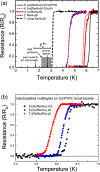Enhanced superconducting transition temperature in electroplated rhenium
- PMID: 39449750
- PMCID: PMC11500058
- DOI: 10.1063/1.5027104
Enhanced superconducting transition temperature in electroplated rhenium
Abstract
We show that electroplated Re films in multilayers with noble metals such as Cu, Au, and Pd have an enhanced superconducting critical temperature relative to previous methods of preparing Re. The dc resistance and magnetic susceptibility indicate a critical temperature of approximately 6 K. The magnetic response as a function of field at 1.8 K demonstrates type-II superconductivity, with an upper critical field on the order of 2.5 T. Critical current densities greater than 107 A/m2 were measured above liquid-helium temperature. Low-loss at radio frequency was obtained below the critical temperature for multilayers deposited onto resonators made with Cu traces on commercial circuit boards. These electroplated superconducting films can be integrated into a wide range of standard components for low-temperature electronics.
Figures




References
-
- Mukhanov OA, IEEE Trans. Appl. Supercond 21, 760 (2011).
-
- Herr QP, Herr AY, Oberg OT, and Ioannidis AG, J. Appl. Phys 109, 103903 (2011).
-
- Manheimer MA, IEEE Trans. Appl. Supercond 25, 1301704 (2015).
-
- Holmes DS, Ripple AL, and Manheimer MA, IEEE Trans. Appl. Supercond 23, 1701610 (2013).
-
- Kotsubo V, Radebaugh R, Hendershott P, Bonczyski M, Wilson B, Nam SW, and Ullom JN, IEEE Trans. Appl. Supercond 27, 9500405 (2017).
Grants and funding
LinkOut - more resources
Full Text Sources
Other Literature Sources
